October 26th, 2008 by matt
So the two monumental buildings in Ludlow are its church and castle. Both are the center of the reason for Ludlow’s existence. As it was an administrative center and then social center of the region, there was much money flowing around. And, this being a time where religion was one of the foci of life, it was common for wealthy people to show their devotion by giving money to the church. It’s still done today, but not nearly on the scale as the Middle Ages and Early Modern Europe. As a result, a town the size of Ludlow is able to have a church like this:
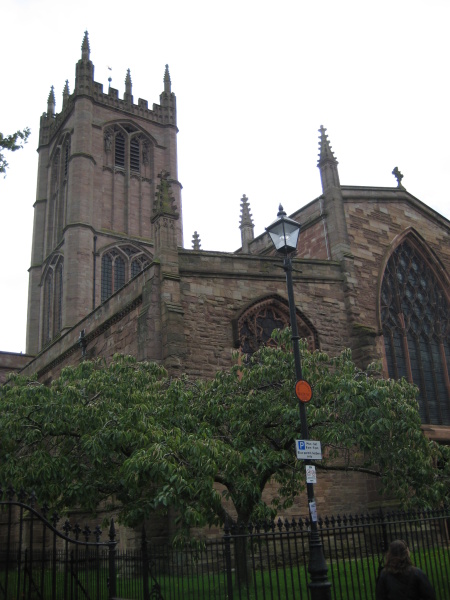
Here’s what it looks like from the interior:
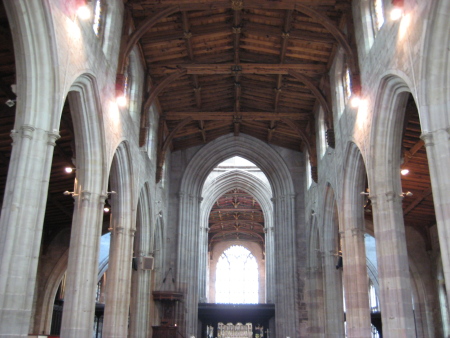
Quite large for what is now a small rural market town. That big bell tower can be walked up, which we naturally did. We accidentally timed it for the noon bells which were quite lovely to listen to from above them. Now, I used to have a lot of fear about heights. As I got older, I overcame most of my fears, which one exception: spiral staircases. Alas, they usually lead to some pretty nice places, so I always go up them, but by the end, I’m usually sweating and completely freaked out. This was no exception. Keeping in mind that I’m not a small person, look at Carolyn as she’s about to descend to earth again.
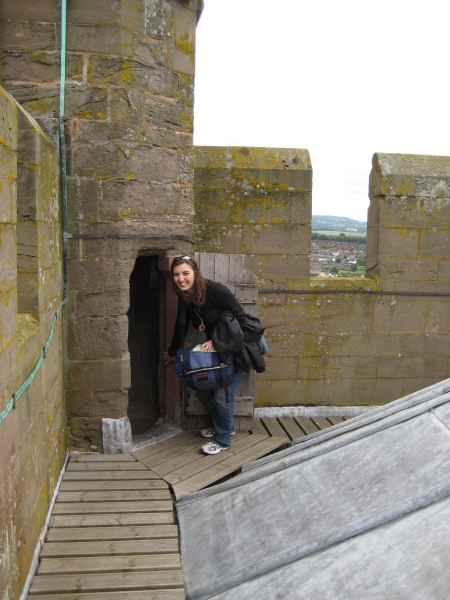
Small and you have no idea where the end is until you fall down them and die or make it on your own two feet. 🙂
From the top of the bell tower, you can catch a glimpse of the other monumental building in Ludlow, the castle:
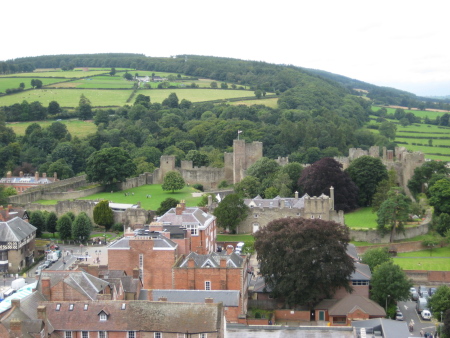
The castle was originally a Norman garrison for the nobleman that William the Conqueror chose to lord of the land in order to keep control of the newly conquered island. It expanded over the years until Ludlow was controlling the Marches and Wales. As Ludlow declined in importance, the castle feel into decay. However, castles that end up as ruins can be the most fun to explore. This one was quite impressive. It wasn’t a complete shell of a building which meant there were tons of corners and rooms to explore. And the owners of the castle have left it all quite accessible. I enjoyed it so much, I took about 70 photos just of it. And here they all are!! I mean, here is a small sampling of them.
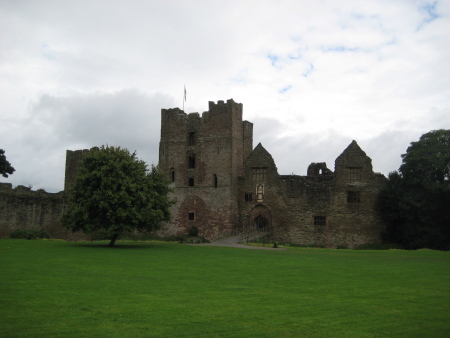
Here is the main exterior of the castle. It’s perched on a cliff above the river (and Mr. Underhils) so it was well placed to ward off any attacks.
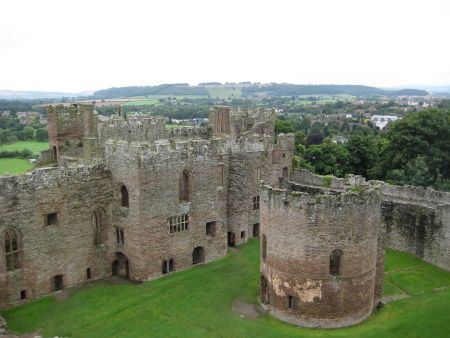
This is a view from inside the castle itself. The cool round building was a Norman chapel. It was possible to check out all those rooms off the inner courtyard.
Posted in Photos, Travel | Comments Off on Ludlow Church and Castle
October 20th, 2008 by matt
So, now you know that Ludlow exists and that it has some beautiful places to stay and eat. But what about the town itself? Well, while we were there, we took a walking tour with a local architectural and historical society and there was much to be learned. Ludlow is a border town. It’s in a region called the Marches which essentially means a border. This would be the Welsh border and, when the UK absorbed Wales in the 15th Century, an administrative body call the Council of the Marches was set up and Ludlow was the administrative centre. Originally just a castle, Ludlow was suddenly something of a capital now and a town sprang up around it. It is also a market town, meaning people from the country sides came in weekly to buy and sell goods in a central location.
In the 17th Century, the Council of the Marches was abolished, but Ludlow survived by being a fashionable market town and, since it took 27 hours to get to London from Ludlow at the time, it retained an air of cosmopolitanism. However, with the arrival of the train in the 19th century, which connected the far-flung (relatively) reaches of Britain, Ludlow began a quick and steady decline. If it helps, you can now get from Ludlow to London in 3 hours.
Now, the decline of any place is not a good thing, but in this case, there’s a silver lining. While much of old England got torn down in the mid-20th century and was replaced by some horrible modernist concrete architecture (some of it by choice, some because the Germans bombed the shit out of many English cities), Ludlow laid forgotten. And this meant that a slice of English architectural history was perserved so, when the preservation movement sprung up, there was a town with 400 examples of English Architecture. Half-timbered buildings are all over the place and a gigantic cathedral towers over it all, a sign of the former power and money that used to flow into this small market town. Let’s take a look.
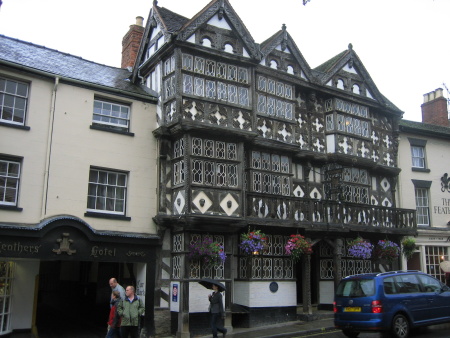
The Feather’s Hotel is a classic, and Ludlow’s most elegant example of the half-timbered building. A timbered frame is erected and the gaps in the timber are filled with things like mud or, later on, concrete. Typically, the white parts you see were likely painted with some color and not white. The wood is oak which, when cut is still quite soft, but then hardens quickly and perserves very nicely.
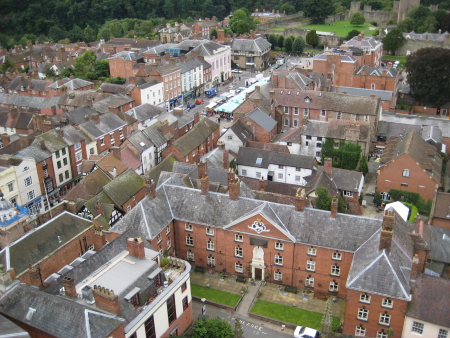
Ludlow from above. The green and white striped tents are the market, which still is around today, 3-5 days a week. And people still come into to town to do their weekly shopping. Note the edge of the castle in the background (much more on that later).

One of the best grouping of old buildings. Note the large large bell tower of the church behind it.
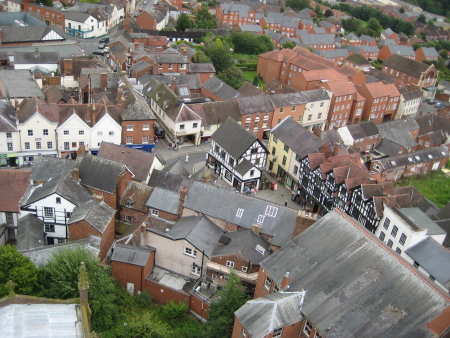
Another view of Ludlow from the bell tower and some more examples of half-timbered buildings.
Next, I’ll show more of the church, the river Teme and the castle.
Posted in Photos, Travel | 1 Comment »
October 11th, 2008 by matt
Hmmm, has it been a month? Well, let’s catch up. As you may recall, we didn’t take an official honeymoon after our wedding. Carolyn’s parents were most kind and gave us a couple of days in NYC in lieu of that, so we decided to just have a number of small honeymoons until we took the real one (more on the real one later). It was a lovely time. August was time for honeymoon #2, this time thanks to my parents. Since we’d done a big city US honeymoon, this time around we thought we’d try the English country-side. After a little hunting around, we found a place called Ludlow, which is the foodie capital of the small towns. At one point, it had three Michelin starred restaurants in a town of 10,000. We spent a weekend here, staying in and eating in one of those restaurants. Today, I’ll fill you in on that piece of the weekend and write about the town of Ludlow and the cool-ass castle in some other posts.
We stayed at Mr. Underhill’s, an inn and lovely restaurant on the banks of the River Teme in Ludlow. Ludlow is about 12 miles from the Welsh border surrounded by beautiful rolling hills. Mr. Underhill’s is at a perfect bend in the river with a man-made waterfall (called a weir) and an ancient one-lane bridge nearby that’s leads up into the hills. It sits right under the castle in Ludlow, which is perched above it. As a result, it had a wonderful feel of isolation, even if the town was just around the corner. And the inn and restaurant were in a private courtyard which gave a nice peaceful feel to it:
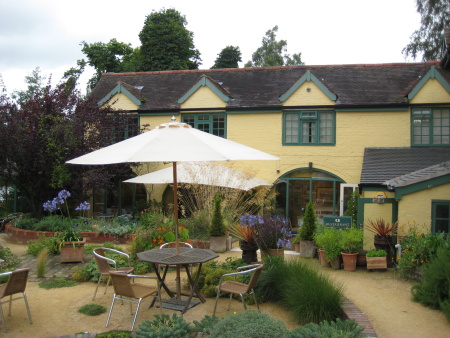
Our room was a cute, well furnished room that allowed us to watch the Olympics in the mornings. And the place included breakfast. This might not mean much except for the fact that the big draw of staying at this particular place was the food. Mr Underhill’s, while it might be in a small market town 4 hours from London, has a Michelin star. So we had breakfast in a Michelin starred restaurant (it was damn fine). I don’t think either of us had eaten at a place like this, so we were curious to give it a try. And, when we booked the room, we booked dinner for our second night there. A nice romantic dinner along a beautiful river.
Dinner was everything we expected. It was about 9 courses, most dishes being smaller taster dishes with a main course that was a little bigger. The restaurant itself was very unpretentious. It was a husband and a wife who ran the place and the wife was always out in front chatting with people and happy to answer questions. The dress was casual-ish and their cat would wander in and find a comfortable place to chill out with all the folks eating their dinner. The menu changed daily and you didn’t know what you were going to get until you sat down. Whatever they could find in the markets that day went into the meal. Here are our main courses:
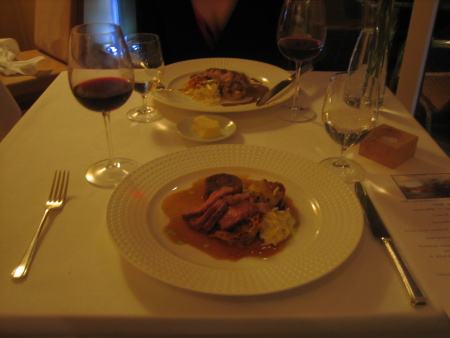
Fancy and delicious food, but none of the “we have a Michelin star” pretension. Dinner took about three hours, at which point we were full and content. I have the menu scanned, but I need to dig it up. I’ll post it when I find it.
The dining room was cosy (10 tables) and comfortable. The whole place has a nice intimate and friendly atmosphere. From the rooms to the food, it was very pleasant:

Now, we did more than just hang out at this inn, but that’ll be for the next post about Ludlow.
Posted in Photos, Travel | 3 Comments »
fuck fuck fuck fuck fuck fuck fuck fuck fuck fuck fuck fuck fuck fuck fuck fuck fuck fuck fuck fuckfuck fuck fuck fuck
|

My name is Matt, I live in a hat, I have two cats, one wife and I don't own a bat.
For those of you curious about the title, I've taken it from a character with that name on the old Jim Henson show called Fraggle Rock.
Are you illiterate? Well, you can see my London world in map form as well!
Here are some relevant links for those interested:
|














